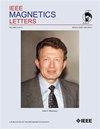磁性纳米粒子超宽带铁磁共振检测GDF15蛋白
IF 1.1
4区 物理与天体物理
Q4 ENGINEERING, ELECTRICAL & ELECTRONIC
引用次数: 0
摘要
本研究开发了一种生长分化因子-15 (GDF15)蛋白检测方法,该方法使用频率高达67 GHz的超宽带微带线型探针。我们使用一抗和二抗制备了结合GDF15和磁性纳米颗粒(MNPs)的样品。高密度的次级MNPs与抗原反应多次,利用生物素-亲和素反应在覆盖玻璃上增强磁信号。抗原与MNPs之间的反应通过荧光粒子和振动样品磁强计证实。直流磁场的应用增强了锐利铁磁共振(FMR),提高了GDF15检测的信噪比。随着GDF15浓度(0、0.01、0.1和1µg/ml)的增加,1.5和2 T间FMR强度的差异明显增大。获得了可重复的蛋白(GDF15)检测校准曲线。该方法有望在生物医学应用中实现灵敏、定量的蛋白质检测。本文章由计算机程序翻译,如有差异,请以英文原文为准。
Detection of GDF15 Protein Using Ultrabroadband Ferromagnetic Resonance of Magnetic Nanoparticles
This study developed a protein detection method of the growth differentiation factor-15 (GDF15) using a ultrabroadband microstrip line type probe up to 67 GHz. We prepared samples that bound the GDF15 and magnetic nanoparticles (MNPs) using primary and secondary antibodies. High-density secondary MNPs reacted with antigen several times to enhance the magnetic signal using a biotin–avidin reaction on a cover glass. The reaction between the antigen and the MNPs was confirmed by fluorescent particles and a vibrating sample magnetometer. The application of the dc field enhanced sharp ferromagnetic resonance (FMR), improving the signal-to-noise ratio for GDF15 detection. The difference in FMR intensity between 1.5 and 2 T increased clearly with increasing GDF15 concentration (0, 0.01, 0.1, and 1 µg/ml). A reproducible calibration curve was obtained for protein (GDF15) detection. Our method shows promise for sensitive and quantitative protein detection in biomedical applications.
求助全文
通过发布文献求助,成功后即可免费获取论文全文。
去求助
来源期刊

IEEE Magnetics Letters
PHYSICS, APPLIED-
CiteScore
2.40
自引率
0.00%
发文量
37
期刊介绍:
IEEE Magnetics Letters is a peer-reviewed, archival journal covering the physics and engineering of magnetism, magnetic materials, applied magnetics, design and application of magnetic devices, bio-magnetics, magneto-electronics, and spin electronics. IEEE Magnetics Letters publishes short, scholarly articles of substantial current interest.
IEEE Magnetics Letters is a hybrid Open Access (OA) journal. For a fee, authors have the option making their articles freely available to all, including non-subscribers. OA articles are identified as Open Access.
 求助内容:
求助内容: 应助结果提醒方式:
应助结果提醒方式:


